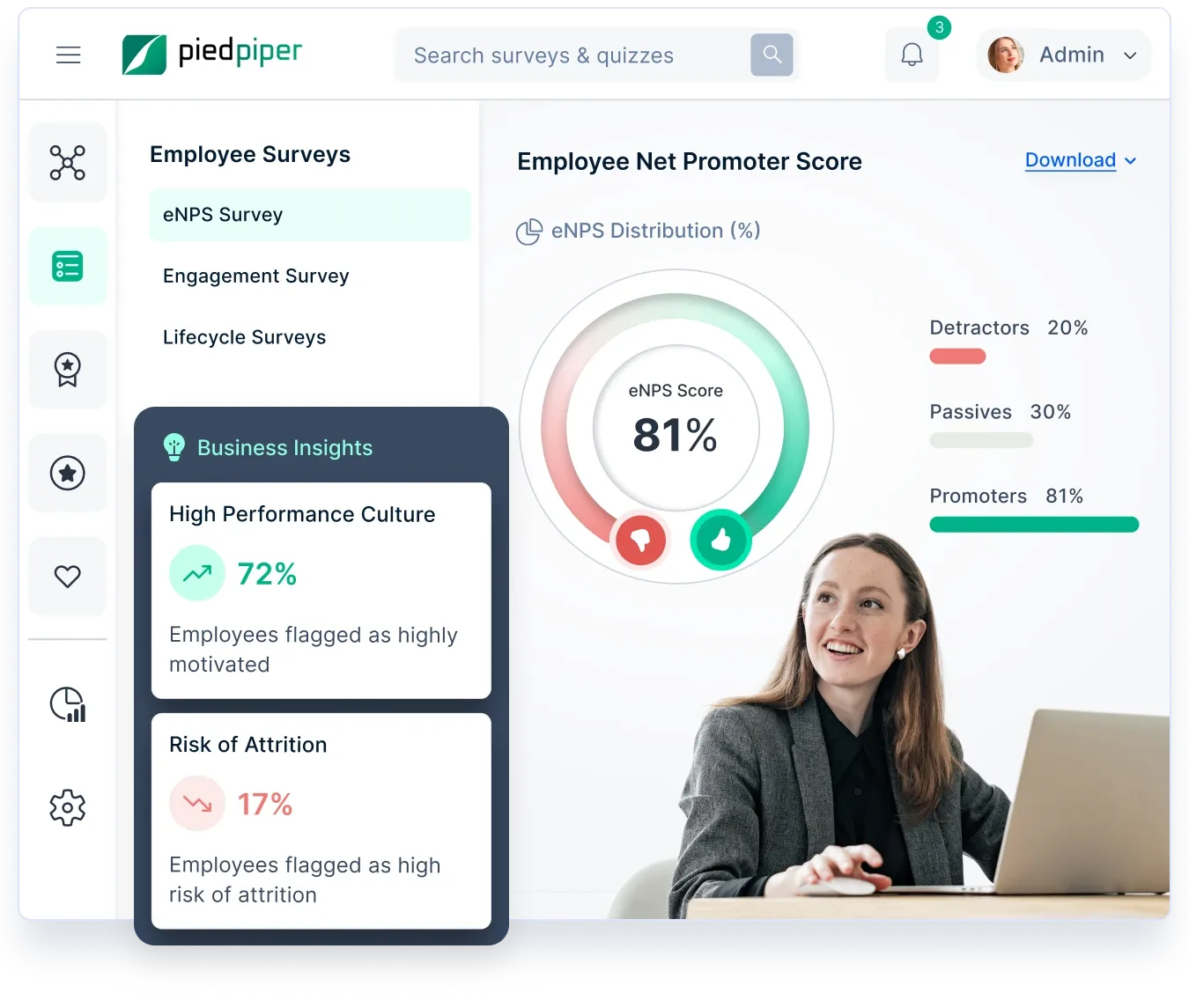Demotivation in the Workplace: Signs, Causes, and How to Motivate a Demotivated Employee
Employee demotivation can impact productivity, morale, and retention. Learn to identify signs of demotivated employees, understand the causes of demotivation in the workplace, and apply effective strategies to motivate a demotivated employee before disengagement spreads.
في هذه الصفحة
Even the most engaged and high-performing teams experience slumps. One moment, your employees are proactive and energized; the next, they’re disengaged, making errors, and struggling to complete routine tasks. This shift isn’t always due to laziness or lack of ability—it's often a sign of employee demotivation creeping in.
Ignoring these warning signs can have serious consequences. A lack of motivation spreads quickly, impacting productivity, morale, and even retention rates. Recognizing the signs of demotivated employees early on is crucial for managers who want to maintain a thriving work environment. From missed deadlines to increased absenteeism, the indicators are often clear—but the root cause isn’t always obvious.
Understanding the causes of demotivation in the workplace is the first step toward reversing it. Whether it’s due to a lack of recognition, unclear expectations, or excessive workload, pinpointing the factors leading to demotivation allows leaders to take meaningful action.
But knowing how to motivate a demotivated employee is what truly makes a difference. With the right strategies, you can re-energize your workforce, rebuild engagement, and create an environment where employees feel valued and driven to perform their best.
10 علامات على الموظفين المحبطين في مكان العمل
دعونا الآن نناقش الأعراض أو علامات الإحباط البارزة في مكان العمل ، والتي هي في الواقع خصائص الموظف المحبط في الوضع الطبيعي الجديد:
1. التغيب أو التأخر المستمر
هل تبين أن المتدرب الإداري الذي اعتاد على سحب كل الليالي خلال المواعيد النهائية للمشروع هو مدير تنفيذي "عالق إلى الأبد في حركة المرور"؟ هل يولد المدير التنفيذي الذي كان "لا يغيب أبدا" أسبابا جديدة رائعة لتخطي العمل؟
اشتقت دراسة أجريت عام 2012 أن أعلى ارتباط إيجابي ل "الحفاظ على الوقت" هو "عقلية العمل". كان هذا من بين 21 عاملا تنظيميا تم تقديمها إلى 402 موظف من خمس شركات في NCR ، دلهي.
The study thus indicates that those punctual people out there - are business drivers, too. Time to carve a plan of employee engagement and motivation if your employees have daily hassles with traffic.
2. موقف اللامبالاة
هل يتصرف أحد أعضاء فريقك بالطريقة التي يتصرف بها شريكك عندما يكون في مزاج سيء؟ كما لو أن كل ما يريدون أن يكونوا عليه هو ترك وحدهم؟ هذا يحدث حتى خلال موسم الزيادة عندما يخرج بقية الفريق بأنفسهم المذهلة؟ تحقق بشكل أفضل من هذا الشخص.
S. Bishvas’s 2010 study surveyed 357 managers/executives from manufacturing and service sector companies, studied their responses on five factors - psychological climate, job satisfaction, job involvement, turnover intention, and organizational effectiveness – and concluded that there was a high positive influence of psychological stress climate over job satisfaction.
وبعبارة أخرى ، إذا كانت هناك أي مؤشرات على الإجهاد النفسي لدى الموظف - فهي أيضا علامة حمراء للقائد.
3. الصراع مع الأقران / الرئيس
An employee retention study by Iowa State University showed that stayers engaged in more positive behaviors than leavers. Have suddenly the rights become too vast or flexibility too undefined?
هل تشعر بأنك مصور كرأسمالي في كل مرة تفي فيها بمسؤوليات وظيفتك في إدارة أداء الفريق؟ حان الوقت لعقد مؤتمر للمصالحة.
4. الإجهاد المستمر / الملل
تشير دراسة H J Carla التي أجريت على 700 موظف عبر الوكالات المتوسطة والكبيرة الحجم في ولاية كارولينا الجنوبية إلى أن مشاركة الموظفين هي المفتاح للاحتفاظ بعمال اليوم.
إذا كنت تعرف أنه لا يوجد عمل كاف لأي من أعضاء فريقك ليكون على المكتب طوال الوقت وإذا كان هذا الشخص لن يأخذ فترات راحة منتظمة ، فمن الضروري معرفة السبب.
No, they are not having a heated break-up discussion over messages - which you are sympathetic about – they are scoring high in a recently downloaded arcade game over your office Wi-Fi. Better check out their scores!
5. يؤدي المناقشات السلبية
يوضح S. Biswas ملاحظاته في دراسة أجريت عام 2010. ويقول:
"يعتمد مقدار مشاركة الفرد في وظيفته على القوة الإيجابية التي يدرك بها نفسيا الجوانب المختلفة لوظيفته وبيئته الوظيفية".
وبالتالي ، عندما يتم اكتشاف أن عضو فريقك يسخر بشكل متزايد من مبادرات الاستدامة والإدارة للشركة - فقد حان الوقت بلا شك لإجراء حفر أعمق.
6. انخفاض في الإنتاجية ونوعية رديئة من العمل
واستمدت دراسة باكوتيتش على 40 شركة كرواتية كبيرة ومتوسطة الحجم ارتباطات كبيرة بين الرضا الوظيفي والمؤشرات المالية للإنتاجية التنظيمية.
التقارير غير المكتملة، وأوراق البيانات الخاطئة، والكثير من الوقت الخامل هي مؤشرات عامة لاجتماع استعراض مؤقت. يمكن أن يكون أيضا لروح مكسورة محتملة - اكتشف ذلك بشكل أفضل.
7. الانسحاب من فعاليات مشاركة الموظفين
تظهر دراسة Erdila et al على 195 موظفا عملوا تحت إشراف في اسطنبول تجريبيا أن متعة مكان العمل ترتبط بشكل إيجابي بالمشاركة وتولي المسؤولية.
هل الفراشة الاجتماعية الآن فراشة داخلية؟ تحتاج إما إلى إعادة النظر في شمولية برامج الموظفين الخاصة بك أو إجراء دردشة مع الفراشة.
8. لا يقوم بمبادرات جديدة
وخلص هارت وآخرون، في دراستهم التي أجريت عبر 36 شركة ومع 198514 المستجيبين، إلى أن مشاركة الموظفين ترتبط بنتائج أعمال ذات مغزى على نطاق كبير عبر الشركات.
انظر إلى ذلك الملف القديم المتربة بعنوان "طرق لتحقيق أقصى قدر من الكفاءة في العمليات غير المتزامنة بما يتوافق مع دورة العمليات التجارية" ، واترك تنهيدة ثقيلة على مدى كثافة مشاريع المتدرب بدون أجر. لا توجد مبادرات من نفس "المتدربين آنذاك" - الآن المنتسبين؟ الوقت حتى مكثفة واحدة على تلك.
9. زيادة النشاط على مواقع الشبكات المهنية
A statistic published by Linkedin tells that out of the 200 million who log in to Linkedin daily, 22 million apply for a job.
هل ترى إشعارات متكررة حول التحديثات في الصفحة الاحترافية لعضو فريقك؟ كما أنه لا يبدو وكأنه تحديث حالة غير ضار ولكن إعادة تشغيل ملف التعريف بالكامل؟ الاحتمالات العالية هي أن ال 22 مليون لديها الآن زائد واحد.
10. لا يساهم بمسؤولية في المناقشات
Has the ‘can’t-stop-asking-questions’ person turned to a ‘can’t-keep-eyes-open’ person? Herzberg's motivation-hygiene theory famously quotes ‘responsibility, opportunity to do something meaningful’ as prime motivation factors.
يشير غياب المبادرة للمشاركة في مثل هذه الفرص التي توفرها المنظمة إلى أن الشخص لم يعد يعتبرها عاملا محفزا.
Causes of employee demotivation in the workplace
Employee morale, unquestionably, is one of the most vital but most difficult things to manage in a company.
يمكن أن تكون الروح المعنوية المنخفضة المستمرة مصدر قلق خطير لمؤسستك ، حيث يؤدي الموظفون غير الراضين إلى ارتفاع معدل دوران الموظفين وسوء خدمة العملاء وانخفاض الإنتاجية.
Therefore, understanding what are the possible factors that are causing low staff morale or low employee motivation can help to fight the challenge head-on.
Here are some of the most common factors that demotivate employees:
1. عدم وجود التنمية المهنية / الشخصية

يبحث الموظفون باستمرار عن فرص للنمو في دورهم الحالي والتحدي بطرق جديدة ، مع مشاريع / مهام جديدة ، إلخ.
عندما يفشل الموظفون في رؤية كيف سيتقدم مسار حياتهم المهنية داخل المنظمة ، أو كيف يمكنهم تطوير مهاراتهم المهنية أثناء القيام بما يفعلونه ، فقد يكون ذلك غير مرض للغاية.
When workers believe they lack the capacity to carry out a task, they won’t be motivated to do it.
2. عدم الوضوح

لا شيء يثبط عزيمة الموظفين / يسحب الروح المعنوية إلى أسفل مثل عدم الوضوح. عندما لا يعرف الموظفون ما هو متوقع منهم أو ما هي الأهداف التنظيمية ، ينتهي بهم الأمر بقضاء أيام (أحيانا أسابيع) في القيام بنفس المهمة - دون أي نتائج ملموسة.
هذا لا يعيق الموظفين من الأداء بأفضل ما لديهم فحسب ، بل يثبط عزيمتهم ويعززهم. عندما لا تتصل المهمة بشيء يقدره العمال أو تساهم فيه ، فلن يتم تحفيزهم للقيام بذلك.
3. انعدام الأمن الوظيفي
Employees who work for unstable companies or in jobs that are insecure will only invest enough to keep getting their paycheck while they look elsewhere. The rest of their energy will be spent sharing rumors with co-workers, updating their resumes, and planning their next move.
أفضل ما يمكنك فعله هو التواصل بشكل متكرر ومنح فريقك شعورا بالولاء والثقة. يجب عليك معرفة سبب شعور الموظفين بالأمن الوظيفي والتخفيف من هذه الأسباب. يمكن أن تؤدي معدلات الاستنزاف المرتفعة إلى مشاكل معنوية متتالية في جميع أنحاء المنظمة.
4. قلة التواصل

يعد نقص التواصل أحد أكثر عوامل تثبيط الموظفين تحديا. يمكن أن يكون التغيير ساحقا ويصعب التعامل معه.
سواء كان ذلك تغييرا في القيادة ، أو بيئة العمل ، أو هيكل الفريق ، وما إلى ذلك ، أو التحول المفاجئ إلى العمل من المنزل (في حالة مثل حالة جائحة COVID-19 الأخيرة) ، يمكن أن يكون التغيير صعبا للغاية.
عندما يكون هذا مصحوبا بنقص في التواصل ، فإنه يؤدي فقط إلى مزيد من الارتباك والغموض وانخفاض المشاركة.
5. عدم المرونة في مكان العمل
في حين أن معظم موظفيك يفهمون أن أعباء العمل يمكن أن ترتفع وتنخفض ، فإن مطالبة أحد موظفيك بمواكبة عبء العمل غير المعقول لفترات طويلة من الزمن يمكن أن يؤدي إلى الإرهاق والاستياء.
Also, if your company policies are so stringent that it's making the work more complex and tough for your employees rather than helping them succeed at work, then such policies do more harm than good.
إذا أدى إجهاد العمل والإرهاق إلى مشاكل صحية مع الموظفين ، فسيؤدي ذلك بالتأكيد إلى تثبيط الموظفين.
6. الشعور بعدم الظهور في مكان العمل

يريد الناس أن يكونوا موضع تقدير لجهودهم وتفانيهم. عندما يفشل المديرون في التعرف على العمل الجاد والتفاني لموظفيهم ، فغالبا ما يؤدي ذلك إلى شعور الموظفين بأنهم غير مرئيين داخل المنظمة - مما يؤدي إلى فقدان احترام الذات وانخفاض معنويات الموظفين وفك الارتباط.
7. Failing to address company mission, vision & values
إذا كانت هناك مشكلات متسقة حول بعض السياسات المتعلقة بقسم أو جنس أو موقع ولم تتم معالجة مثل هذه المشكلات ، فهناك فرص كبيرة لأن يبدأ الموظفون في تثبيط عزيمتهم للعمل مع الشركة.
يشعرون بعدم الأمان ويبدأون في انخفاض الثقة في الإدارة. يمكن أن تكون هذه القضايا مرتبطة بأي معلومات مضللة عامة ، وأي إطلاق نار ، وأي تحيز جنساني ، وتحرش جنسي ، وتحيز عرقي ، وما إلى ذلك.
إذا كانت الشركة لا تحقق أو تتصرف بشأن مسألة سوء سلوك جسيم ، فقد تسوء معنويات الموظفين.
8. انعدام الثقة أو الإدارة الجزئية

Managers often tend to get into micromanagement of their team members’ work when they don’t trust them enough.
إنهم يميلون إلى المشاركة في كل خطوة من خطوات تنفيذ المشروع ، وإخبار موظفيهم بما يجب عليهم فعله ، وكيفية القيام بذلك ، وفي بعض الأحيان يجلسون معهم لإنجازه على طريقتهم.
إنه أمر محبط ومحبط ومحبط. يتوقع الناس مستوى معينا من الحرية والسلطة لاتخاذ قراراتهم الخاصة في حدود أدوارهم الوظيفية.
How to motivate a demotivated employee: 6 Most effective ways
Here are six effective ways to motivate a demotivated employee while addressing employee demotivation and the demotivating factors that might be causing it.
1. Identify and address demotivating factors
The first step in understanding how to motivate a demotivated employee is identifying what’s causing their disengagement. Employee demotivation can stem from several demotivating factors, such as unclear job expectations, lack of recognition, stagnant career growth, or a toxic work environment.
Conducting one-on-one meetings, gathering feedback through anonymous surveys, or having open discussions can help uncover these underlying issues. Once identified, take corrective actions like clarifying job roles, improving team dynamics, or addressing workload concerns. Employees feel valued when they know their concerns are heard and actively addressed.
2. Provide meaningful recognition and appreciation
A major demotivating factor is feeling unappreciated. Employees who don’t receive recognition for their hard work often lose interest and engagement. A simple ‘thank you’ or acknowledging their contributions in team meetings can uplift their spirits. However, recognition should be structured and meaningful rather than just an occasional appreciation.
Platforms like Empuls offer a seamless way to implement an effective rewards and recognition system. Organizations can appreciate employees through peer-to-peer recognition, milestone rewards, and performance-based incentives. Integrating such tools can create a culture where employees feel valued, boosting motivation and workplace morale.
3. Offer opportunities for growth and development
Employees who see no career progression or skill development in their role are likely to experience employee demotivation. The absence of learning opportunities and stagnant roles can make them disengaged.
Providing skill-building workshops, mentorship programs, and clear career growth paths can reignite their enthusiasm. Assigning them to meaningful projects that challenge their skills or sponsoring professional development courses can also make a difference. Employees who see a future in the organization stay more committed and driven.
4. Improve work-life balance and reduce stress
Burnout and excessive workload are among the most common demotivating factors. When employees feel overworked without sufficient breaks or flexibility, their productivity and motivation suffer.
Encourage a healthy work-life balance by offering remote work options, flexible schedules, or wellness initiatives. Simple changes like allowing mental health days, reducing unnecessary meetings, and promoting a supportive work environment can lead to significant improvements in motivation. Employees who feel their well-being is prioritized are more engaged and committed to their work.
5. Set clear goals and provide autonomy
Unclear expectations and micromanagement often contribute to employee demotivation. Employees need to understand their role, what’s expected of them, and how their contributions impact the bigger picture. Without clear direction, they may feel lost or undervalued.
Set measurable and achievable goals while allowing employees to execute tasks their way. Avoid constant supervision—trusting employees with responsibilities fosters confidence and motivation. When they have ownership over their work, they feel more accountable and invested in their tasks.
6. Conduct employee surveys and act on feedback
Understanding how to motivate a demotivated employee requires continuous feedback. Conducting employee surveys helps in identifying demotivating factors that might be causing disengagement. However, collecting feedback is just the first step—acting on it is what truly makes a difference.
Empuls offers an advanced employee survey tool that helps organizations track engagement levels, collect honest feedback, and implement necessary changes.
Regular pulse surveys, engagement check-ins, and satisfaction assessments allow HR teams to address workplace concerns before they escalate. When employees see that their input leads to real improvements, they feel more valued and motivated.
Organizations can create an engaging and rewarding work environment by addressing demotivating factors and implementing structured ways to motivate a demotivated employee. Investing in recognition, career development, work-life balance, autonomy, and employee feedback leads to long-term motivation and retention.
Reignite employee motivation with Empuls
Demotivation doesn’t happen overnight. It creeps in when employees feel unheard, unappreciated, or disconnected from their work. A lack of recognition, unclear communication, and an uninspiring workplace culture can quickly lead to disengagement and lower productivity. Empuls helps businesses turn this around by creating an environment where employees feel valued, motivated, and excited to contribute.
Uncover the root causes of demotivation

Employee disengagement isn’t always obvious. Some might struggle with unclear goals, while others feel their contributions go unnoticed. Empuls’ Employee Survey Tool gives employees a voice by collecting real-time feedback. By analyzing engagement trends and pinpointing concerns, organizations can take proactive steps to address workplace frustrations and create a culture where employees feel heard and supported.
Recognize and reward achievements to boost morale

Employees thrive when their hard work is acknowledged. Empuls' Rewards & Recognition platform makes appreciation a seamless part of workplace culture by enabling peer-to-peer recognition, instant rewards, and leadership-driven appreciation. Whether it’s a simple shoutout, a tangible reward, or a structured incentive program, recognition fuels motivation and helps employees stay engaged.
Make milestones meaningful
Celebrating professional milestones isn’t just about acknowledging tenure—it’s about reinforcing commitment and loyalty. Empuls’ Milestone Rewards ensures that every work anniversary, project completion, or performance achievement feels special with personalized rewards and heartfelt appreciation. Employees who feel valued for their long-term contributions remain motivated to stay and grow with the organization.
Create a thriving company culture

A workplace culture that fosters inclusivity, collaboration, and recognition is a powerful antidote to demotivation. Empuls’ Company Culture Software helps build a strong foundation by creating a space where employees can connect, share ideas, and engage in meaningful discussions. A positive culture transforms workplaces from transactional environments into spaces where employees feel inspired and invested in their roles.
Strengthen communication and workplace connections

Poor communication can quickly lead to disengagement, leaving employees feeling isolated and uninformed. Empuls’ Social Intranet acts as a dynamic communication hub where teams can stay updated, participate in discussions, and build a sense of community.
From leadership announcements to team-wide conversations, it ensures that employees feel connected, valued, and part of something bigger.
Demotivation thrives in environments where employees feel overlooked, but Empuls turns disengagement into enthusiasm, fostering a workplace where every individual feels recognized, empowered, and connected.
استنتاج
Employee demotivation isn’t just an individual problem—it affects team dynamics, productivity, and overall workplace culture. Ignoring the signs of demotivated employees can lead to disengagement spreading across the organization, making it harder to recover.
By identifying the causes of demotivation in the workplace, whether it's lack of recognition, unclear goals, or poor work-life balance, leaders can take proactive steps to address the issue. Creating a supportive environment, offering growth opportunities, and using tools like Empuls for recognition and feedback can make a significant difference.
Motivating employees isn’t about quick fixes—it’s about fostering a workplace where people feel valued, heard, and empowered. When businesses invest in their employees' well-being and motivation, they build a culture of engagement, loyalty, and long-term success.













